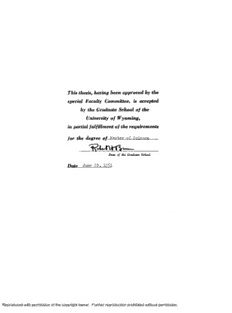
The Diels-Alder reactions of m- and p-nitrostyrenes PDF
Preview The Diels-Alder reactions of m- and p-nitrostyrenes
This thesis, having been approved by the special Faculty Committee, is accepted by the Graduate School of the University of Wyoming, in partied fulfillment of the requirements for the degree o/-lias_ter__of__£.cieiiQ£.____ ___________ Dean of the Graduate School. Date Jyn§_.22jL_i2£i Reproduced with permission of the copyright owner. Further reproduction prohibited without permission. Reproduced with permission of the copyright owner. Further reproduction prohibited without permission. THE DIEIS^ALDSR REACTIONS OF m- AND p-NITROSTYRSNJS by Virginia M. Hylton H A Thesis Submitted to the Department of Chemistry and the Graduate School of the University of Wyoming in Partial Fulfillment of Requirements for the Degree of Master of Science W'r UTBRARY ^ •* DF THE UNIVERSITY OF WYOMING LARAMIE University of Wyoming Laramie, Wyoming June, 1951 Reproduced with permission of the copyright owner. Further reproduction prohibited without permission. UMI Number: EP20780 INFORMATION TO USERS The quality of this reproduction is dependent upon the quality of the copy submitted. Broken or indistinct print, colored or poor quality illustrations and photographs, print bleed-through, substandard margins, and improper alignment can adversely affect reproduction. In the unlikely event that the author did not send a complete manuscript and there are missing pages, these will be noted. Also, if unauthorized copyright material had to be removed, a note will indicate the deletion. ® UMI UMI Microform EP20780 Copyright 2007 by ProQuest Information and Learning Company. All rights reserved. This microform edition is protected against unauthorized copying under Title 17, United States Code. ProQuest Information and Learning Company 300 North Zeeb Road P.O. Box 1346 Ann Arbor, Ml 48106-1346 Reproduced with permission of the copyright owner. Further reproduction prohibited without permission. hebard room ACKNOWLEDGMENT To Dr, Sara Jane Rhoads, the author wishes to express her appreciation for directing the experimental work and preparation of the thesis, Reproduced with permission of the copyright owner. Further reproduction prohibited without permission. TABLE OF CONTENTS Page INTRODUCTION........................................................... . • . 1 EXPERIMENTAL RESULTS AND DISCUSSION, 10 EXPERIMENTAL......................................................................................................18 SUMMARY ........................... . . . . . . . . . . . . 25 Reproduced with permission of the copyright owner. Further reproduction prohibited without permission. LIST OF TM3LE? page TABLE I 17 Reproduced with permission of the copyright owner. Further reproduction prohibited without permission. T“R*.R of srtjrHiE Page FIliURE 1 . . , ................................................................. 19 Reproduced with permission of the copyright owner. Further reproduction prohibited without permission. H W INTRODUCTION Isolated examples of the Dieis-Alder synthesis were to be found in the early chemical literatu re,1a but little significance was 'a J. A. Norton, Chem._ Rev.. 31. 319 (1942); b) H.v. Euler and K. 0. Josephson, J£§r., £2, 822 (19207; c) 0. Diels, J. Blorn, and W. Koll, Ann., 44-3. 242 (1925); d) K. Alder, "Newer Methods of Preparative Or ganic Chemistry," Interscience Publishers, Inc., Nsw York, N. Y., 19A8, p. 381 ff. attached to these until, in 1925, Diels and Alder noted the sim ilarity between a reaction of benzoquinone with isoprene1^ and a reaction of azodicarboxylic ester with cyclopentadiene and isoprene derivatives. In 1928, as a result of three years of research, they published the first paper setting forth a type of reaction now known as the diene synthesis. This reaction involves 1,4-addition of an olefinic compound to a diene, accompanied by a shift of a double bond of the diene, to form a new six-membered ring. The following general equation illu s trates the path of the Diels-Alder reaction. The di9ne (I) varies with the groups R and R', and the dienophile (the olefinic component, (II)) varies with the groups R" and R "'. I II III Reproduced with permission of the copyright owner. Further reproduction prohibited without permission. 2 In general the dienophile must be activated by an electro negative group conjugated with th9 unsaturated double bond. The re action1 a has been observed to proceed most often when the carbonyl group is so conjugated. This group is not essential, however, for nitro-, cyano-, and other electronegative groups activate the dienophile as well. The diene may be a simple compound such as butadiene or a more complicated one such as cyclopentadiene. Benzene and its simple derivatives do not participate as the diene although anethole2 does 2a V. Bruchner and J. Kovacs, J. Org., Cfcem.. 13. 641 (1948); b Ibid., 14, 65 (1949) give a 2:1 adduct with maleic anhydride. Butadiene (I, R=R'=H) reacts readily with acrolein, croton- aldehyde, maleic anhydride and sim ilar compounds. Butadiene reacts with 1-nitro-l-pentene (II, R,fe N02, R"'= at 100-110° in six hours to give a supposedly good yield of adduct.3a In contrast, the 3a K. Alder, H. F. Rickert, and E. Windemuth, |l$r., 71, 2451 (1938); b L. M. Joshel and L. W. Butz, J. Am. Chem. Soc., 63, 3350 (1941)* reaction of butadiene with ethylene to give cyclohexene3*3 requires a tem perature of 200° for seventeen hours at high pressures. Presumably, conjugation of the nitro- group with the olefinic bond in the nitropentene accounts for the difference in activity. Styrene (IV) possesses the qualities of both a diene and a di enophile, but at this point (Jane, 1951) no experiment has been reported Reproduced with permission of the copyright owner. Further reproduction prohibited without permission.
